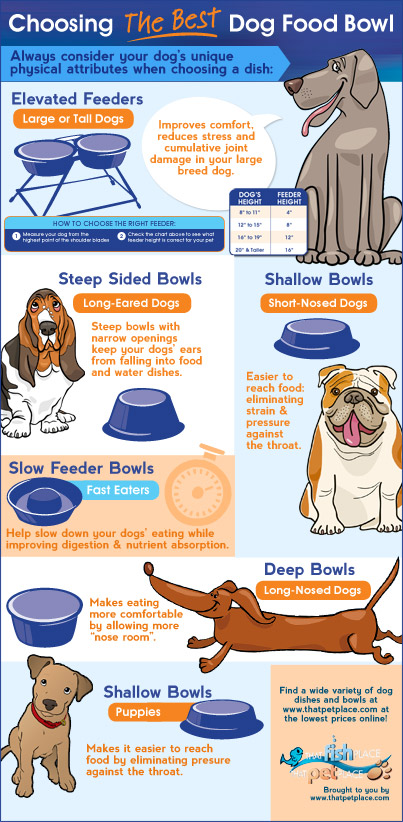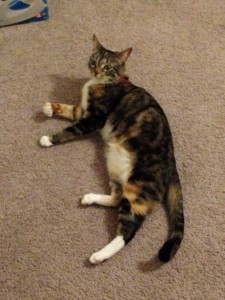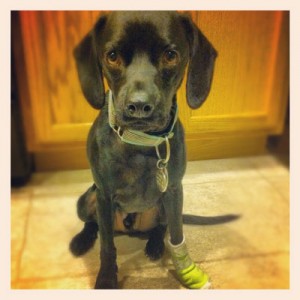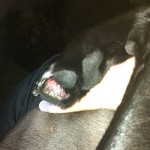If you’ve recently walked down the dog bowl aisle, you’ll know that there are dozens of different sizes and shapes of dog bowls available to choose from. What you might not know is that the different shapes now available are specifically manufactured to meet the specific needs of different dog breeds and age groups. Here at That Pet Place we’ve put together a handy infographic to help you with choosing the right dog bowl that is the perfect match for your pet! Read More »
Category Archives: Pet Health
Feed SubscriptionHow much is too much – What is the real cost of extending our pets’ lives?
If you’ve been a Pet Blog reader for some time now, you know that I treat all of my pets as if they were two-legged family members. They get home cooked meals, birthday parties, and great veterinary care. Each one of them has worked their way deep into my heart, and life without any one of them just wouldn’t be the same. A medical issue has come to a head recently and left me with some very serious topics to consider: How much is too much to spend to extend a loved one’s life, and what is the true cost emotionally, financially and through the suffering of your beloved pets? Read More »
Get Ready for Spring with a New Weight Loss Program for Pets
 We’ve written on numerous occasions about America’s pet obesity epidemic and have provided tips on how to slim and trim your pet. We’re honored to welcome Rainier Fuclan as a guest blogger with a new canine or feline weight loss plan to help our pets lose weight safely. Rainier Fuclan is a marketing strategist, freelance writer and pet lover! When he’s not busy working you can find him at home playing with his dog Peanut and cat Anya.
We’ve written on numerous occasions about America’s pet obesity epidemic and have provided tips on how to slim and trim your pet. We’re honored to welcome Rainier Fuclan as a guest blogger with a new canine or feline weight loss plan to help our pets lose weight safely. Rainier Fuclan is a marketing strategist, freelance writer and pet lover! When he’s not busy working you can find him at home playing with his dog Peanut and cat Anya.
Spring is almost upon us, and with the warmer weather comes the realization that some of us will need to take off a few pounds we’ve gained over the winter months. While you’re taking a critical eye to your waistline, now might be a good time to see whether your four-legged friends could afford to shed a few pounds as well. According to the Association for Pet Obesity Prevention, more than 50 percent of cats and dogs are currently overweight, and one-third of those pets are considered obese, or weighing more than 30 percent over what is considered a healthy weight for them.
Having an overweight or obese pet can be more problematic than just having a few extra pounds of pet to love. Pet owners spend millions of dollars annually to treat obesity-related conditions, and aside from the financial strain on a pet owner’s pocketbook, the pets themselves can suffer from conditions such as kidney failure, diabetes, and cancer. Read More »
Walking the Dog – How Exercising with Your Pets Can Motivate You to Stay Fit
I’m not what you would consider an athletic person. For years I struggled with laziness and weight gain and not even my own deteriorating reflection looking back at me couldn’t get me up and moving to do anything about it. But about a year ago, spurred by an office “biggest loser” competition and the possibility of a substantial cash prize, I finally made the leap and started a walking regime, and walking the dog was the natural way to get going. But you know, it wasn’t long til the money didn’t matter…I started feeling great, eating right, and best of all, I came to realize that daily walks were as rewarding and beneficial for my dog’s physical and emotional well-being as my own. Daily walks and explorations became a necessity, a welcome obligation, and my dogs have become two of my biggest motivators to get moving and get fit.
Now don’t get me wrong, my dogs are active and get plenty of exercise, but that’s all thanks to having access to a fenced back yard, a lovely local dog park, and family lands where they are free to roam, play and run as much as their hearts desire. It’s always been easy just to open the door or take a short drive to let them run, while I enjoyed a maple-shaded park bench or a nap in the grass. Involving my pets in my newly adapted physical regime has become not only one of the most motivating aspects, but also priceless bonding time and a unique chance to really see my four-legged friends in the elements they love. I don’t think I could imagine two better walking partners to keep me on the path to success. Let me tell you why… Read More »
Dealing with Hot Spots – Pet Health
Has your pet ever experienced hot spots? Hot spots, otherwise known as acute moist dermatitis (AMD), are red, oozing lesions that may form on your pet’s skin…they’re kind of wet and scabby. The patches of irritation may start out as an unnoticeable bite, sting, pustule or other minor skin problem, but your dog’s natural instinct to lick, chew and scratch the area leads to a larger, more visible patch which progresses from a minor bump to hair loss, staining, flaking and possibly infection or permanent scars. Hot spots can can be a problem any time of year, and for any dog, and if you’ve ever had a pet develop hot spots you can guess from seeing them how aggrivating and painful they must be to experience. Let’s discuss hot spots and how you can prevent, heal and otherwise deal with AMD.
What Causes Hot Spots?
 Hot Spots have lots of causes, and they rear their ugly heads quickly, and sometimes without any warning. Some of the most common causes are flea or insect bites. Allergens or other irritants that come in contact with your pet’s skin are also a common cause. Small scratches or wounds can also begin an outbreak, particularly as your dog instinctively licks the area. Dogs that experience stress, anxiety or boredom can also scratch or chew, simply to occupy their minds. But the underlying blame falls on bacteria that infest these minor skin breaks, further inflaming an already irritated area. Any dog can develop a hot spot, but dogs who are not washed and brushed regularly, those with sensitive skin, and those with thick, long fur can be more prone to developing hot spots. Read More »
Hot Spots have lots of causes, and they rear their ugly heads quickly, and sometimes without any warning. Some of the most common causes are flea or insect bites. Allergens or other irritants that come in contact with your pet’s skin are also a common cause. Small scratches or wounds can also begin an outbreak, particularly as your dog instinctively licks the area. Dogs that experience stress, anxiety or boredom can also scratch or chew, simply to occupy their minds. But the underlying blame falls on bacteria that infest these minor skin breaks, further inflaming an already irritated area. Any dog can develop a hot spot, but dogs who are not washed and brushed regularly, those with sensitive skin, and those with thick, long fur can be more prone to developing hot spots. Read More »
Getting Personal with Your Pet’s Vital Signs
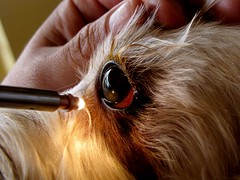 It’s a good practice to get in the habit of performing monthly quick checkups on your pets in the comfort of your own home. You never know when a lump or other malady might show itself. Getting a “baseline reading” of your pet’s body will help you to detect early on when they might be having issues and let you know when it is time to make an appointment with your veterinarian. This article focuses on determining your pet’s baseline vital signs so that you can determine when something is amiss.
It’s a good practice to get in the habit of performing monthly quick checkups on your pets in the comfort of your own home. You never know when a lump or other malady might show itself. Getting a “baseline reading” of your pet’s body will help you to detect early on when they might be having issues and let you know when it is time to make an appointment with your veterinarian. This article focuses on determining your pet’s baseline vital signs so that you can determine when something is amiss.
Temperature: Body temperature is measured rectally in pets (yikes). I keep a spare digital thermometer for my dogs and use a healthy coat of Vaseline if I need to take their temperature. It can come in handy when you are trying to diagnose your sick pet. A dog’s temperature is usually between 100-102.5 degrees Fahrenheit. Any pet with a temperature under 99 or over 104 should see a vet immediately.
Heart Rate: It is best to get a good reading on heart rate when your pet is calm and relaxed, perhaps after a massage or good belly rub. Find the heartbeat on the left hand side of the ribcage, near where the elbow fits into the chest. Count the number of heartbeats for 15 seconds then multiply this number by 4. This is your pet’s resting heart rate. Dog’s heartbeats will accelerate and decelerate with each breath. This is normal! Your pet’s normal heart rate will depend upon the size of your animal. Larger dogs have slower heart rates than lap dogs.
 Respiratory Rate: While your pet is relaxed and calm, maybe even sleeping, it is a good time to determine your pet’s respiratory rate and normal breathing pattern. Avoid measuring this when your dog is panting. Count the number of times your pet inhales for 1 minute. This is the respiratory rate. Also note if it requires your pet any extra effort to inhale or exhale. This function should be smooth and effortless. If your pet is having difficulties, contact a vet immediately.
Respiratory Rate: While your pet is relaxed and calm, maybe even sleeping, it is a good time to determine your pet’s respiratory rate and normal breathing pattern. Avoid measuring this when your dog is panting. Count the number of times your pet inhales for 1 minute. This is the respiratory rate. Also note if it requires your pet any extra effort to inhale or exhale. This function should be smooth and effortless. If your pet is having difficulties, contact a vet immediately.
 Mucous membranes: Your pet’s mucous membranes (read: gums and eyelids) are important in diagnosing problems with oxygenation and blood flow. Normal gum color is pink, but some dogs have pigmented gums (Barret’s are black), and this makes determining if the color is normal difficult. You can open the eye and gently lift the eyelid to get a good look at the coloring. Any membrane that is pale, white, blue or yellow should be investigated by a veterinarian. While you’re examining the mucous membranes, do a quick test for capillary refill time. This is also a good diagnostic tool to determine if blood and oxygen are flowing normally. Briefly apply pressure to the gums and release. The area should turn pale (where you applied pressure) but will rapidly return to the normal color. This refill time should be no longer than 3 seconds but should also not take less than 1 second.
Mucous membranes: Your pet’s mucous membranes (read: gums and eyelids) are important in diagnosing problems with oxygenation and blood flow. Normal gum color is pink, but some dogs have pigmented gums (Barret’s are black), and this makes determining if the color is normal difficult. You can open the eye and gently lift the eyelid to get a good look at the coloring. Any membrane that is pale, white, blue or yellow should be investigated by a veterinarian. While you’re examining the mucous membranes, do a quick test for capillary refill time. This is also a good diagnostic tool to determine if blood and oxygen are flowing normally. Briefly apply pressure to the gums and release. The area should turn pale (where you applied pressure) but will rapidly return to the normal color. This refill time should be no longer than 3 seconds but should also not take less than 1 second.
Hydration: A properly hydrated pet should pass the ‘scruff test’ with flying colors. Gently grab your dog’s scruff (the loose skin on the back of the neck). Release it. The skin should immediately spring back into normal position. If there is a delay, your pet may be dehydrated.
Get into the habit of performing these tests on your pet every few months to keep tabs on their vital signs. I almost forgot the most important part: write down the results and keep them somewhere safe, where you will have access to them in an emergency situation. I use the Pet First Aid app to keep track of my pet’s information (I reviewed this app last year).
A Lump in the Night – Should You See the Vet?
Barret had spent the evening on my lap, as usual, but I noticed after a bit that he was chewing on one of his paws. I got up to examine it and was shocked to find a red, raw, inflamed toe. Just one toe, and it had to be twice the size of the rest of his toes. It looked painful!
I examined his paw for the source of the discomfort, a cut or scratch, maybe a burr or stone, even a bug bite, but could not find anything. He didn’t seem like he was in pain and was perfectly content to lick on his Lickety Stick while I soaked his foot in warm soapy water and bandaged it up. In every other way he seemed completely normal. I made the decision to keep an eye on it and treat it at home.
The next night, he was relaxing on his back while I gave a well-deserved belly rub when I noticed a large lump had formed in his armpit (on the same leg as the swollen toe). Why is it that we find these things after regular vet hours? I hopped on the internet and did some searching. There wasn’t much to go on but I had myself convinced it was a lymph node swollen because of the infection in his toe. The next morning I made an appointment with my regular vet and was fully convinced that I’d leave with a course of antibiotics and instructions to keep the toe clean.
I’m very glad I consulted with my vet, because on further examination my assumption was wrong. The toe was infected, though it was a more severe infection that I had originally thought. It required 2 full courses of antibiotics before it cleared up. The lump on his armpit is another matter entirely. The doc’s conclusion was that it is a cyst with a clearly defined blood supply, but should cause him no problems and doesn’t need to be removed unless it starts to get in his way. Phew!
The moral of the story is that you should always consult your veterinarian rather than making guesses at home. Your kids’ health is at stake! If I hadn’t sought care for Barret’s foot, the infection could have spread and required IV antibiotics or more drastic measures.
Dogs often have lumps and growths all over their bodies and as pet parent’s it is our duty to examine and find these anomalies early, before they get out of hand. Many lumps and bumps, like Bear’s cyst, are benign and nothing to worry about, but a similar lump might actually be cancerous and require treatment. The earlier you find and treat a problem, the easier it is to manage.
Watch for a future article where I’ll go over a step by step home physical so that we can track the changes in our pets bodies and know when to schedule an appointment with the vet. In the meantime, please share your stories of lumps or bumps that turned out to be nothing or turned out to be problematic. We can learn from each other’s experiences.
-Heather
Porcupine Problems – How to Handle a Pet that has been Quilled
 Dogs love to run, play and explore. Their rambunctious ramblings and curiousity may well be some of your favorite attributes about your pet. Personally, I love to watch my dogs off-leash in the countryside where they can run free, roll around and really live life to it’s fullest, even if it’s only for a few hours each week. While we love to let them roam and investigate new places and things, there is always the possibilty that they may run into something unfamiliar or even dangerous in the wild frontier. A single encounter with today’s creature of topic can result in a face full of painful pricks. not to mention anguish (yours and your dogs) and the potential for a hefty vet bill. Let’s talk a little about the prickly porcupine. Read More »
Dogs love to run, play and explore. Their rambunctious ramblings and curiousity may well be some of your favorite attributes about your pet. Personally, I love to watch my dogs off-leash in the countryside where they can run free, roll around and really live life to it’s fullest, even if it’s only for a few hours each week. While we love to let them roam and investigate new places and things, there is always the possibilty that they may run into something unfamiliar or even dangerous in the wild frontier. A single encounter with today’s creature of topic can result in a face full of painful pricks. not to mention anguish (yours and your dogs) and the potential for a hefty vet bill. Let’s talk a little about the prickly porcupine. Read More »
Canine Influenza: What You Need to Know
Have you heard of Canine Influenza? Like the flu that can cause us misery any time of year, this virus is a highly contagious, airborne illness that can affect the respiratory system of your dog if he is exposed. Recently, a number of cases have been reported and confirmed in Lancaster County, triggering the temporary closure of several local kennels and boarding facilities. This virus is easily spread with a cough or a sneeze from an affected pet, and it can be transferred or contaminate any surface, potentially infecting any other dog that walks through the area. While the virus can make your pet quite ill, the bright side is that it is rarely fatal. Here are some other quick facts about Canine Influenza you should know. Read More »
Rabbit Health: How a Misaligned Jaw Almost Killed my Pet Rabbit

Fortunately, Matthew survived. Quick online research confirmed what we already thought; Matthew had suffered a stroke, though minor enough that he regained most of his muscle control. We scheduled a veterinarian appointment and monitored him carefully in the meantime. While he could nibble some of his pellets and try to chew with his right, the left side of his face seemed locked and stiff, and he could not move his lips enough to grasp hay or fully close his right eye.
We figured this was a result of the stroke only, but our veterinarian found a root cause that surprised us. After determining that Matthew’s lips still had circulation and feeling, he used a scope to view Matthew’s back teeth, which are tightly positioned back by the cheeks and almost impossible to examine otherwise. After this check, our vet informed us that Matthew’s jaw was slightly misaligned, causing one of his back left teeth to wear improperly. This created a sharp, uncomfortable point that discouraged him from using that side correctly for a while. The area underneath this tooth became infected, and the infection’s swelling had likely triggered the stroke. While the movement of his left facial muscles would slowly return, the pain from the tooth and infection was discouraging him from using them. Matthew required a few weeks of antibiotics to overcome the infection, along with some rabbit-safe painkiller and anti-inflammatory to encourage proper use of the pointed tooth.
While the vet explained that sedating Matthew and physically filing the back tooth was an option, he did not recommend this after such a high health risk as a stroke. He explained that the location and of the tooth and current discomfort made filing without anesthesia impossible, and our safest bet for Matthew was to see if we could get him to use that side again himself. He also recommended purchasing rabbit-safe cardboard tubes to chew. Unlike normal wooden chews, these would be softer and help prevent making the sensitive area sore. If Matthew still could not wear his tooth enough to be comfortable, sedation and filing was still an option, but it would indicate that he would likely need it every couple of months. Placing a sensitive animal such as a rabbit under anesthesia so frequently is in itself risky, and he suggested we wait on that option unless it seemed necessary.
We left the vet’s office both fearful and optimistic, armed with information, medicine, and a powdered probiotic food to maintain Matthew’s digestive system after his time spent with inadequate eating. As his poor muscle control made using a water bottle difficult, we also boosted his fluid intake with feeding syringes. Providing dishes of water was a poor idea for Matthew; with his poor vision and compromised health, he merely kept his distance from the unfamiliar shape.
After a few days, slow improvements began to show. Matthew’s energy was returning, and he no longer sulked in the back of his cage. He began eating his pellets more regularly and could use his water bottle again, and we stopped the supplemented feed soon after he began his first clumsy bites of hay. He could fully blink his left eye, and movement returned to the left side of his face.
As of today, Matthew seems to be recovered and shows no difficulty grasping, chewing, or biting. While there is no way to correct his conformation, the medications assisted him enough to begin wearing the tooth more properly. I’ve seen many different health conditions in rabbits, but I never expected such an unusual cause as a poor jaw alignment jaw to potentially cause something as serious as a stroke. The vet suggested keeping a close watch for any changes in behavior, as infections as he had can be difficult to truly eliminate in rabbits and might eventually reoccur. For now, Matthew is himself again: stomping for attention, digging at the floor, and watching the activity around him with an alert curiosity.
 That Pet Blog That Pet Place Pet Blog
That Pet Blog That Pet Place Pet Blog

